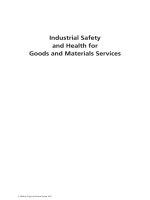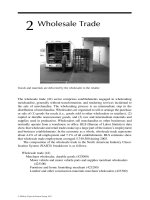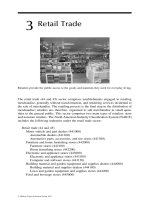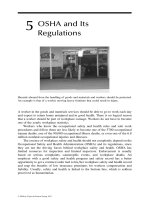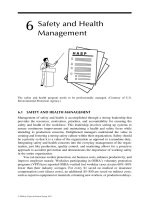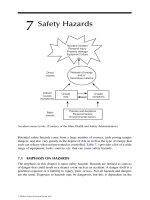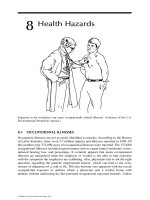Industrial Safety and Health for Goods and Materials Services - Chapter 13 pptx
Bạn đang xem bản rút gọn của tài liệu. Xem và tải ngay bản đầy đủ của tài liệu tại đây (232.14 KB, 18 trang )
13
Ergonomics
Automating the retrieval of shopping carts is a good ergonomic solution.
Ergonomics is by definition fitting the workplace to the worker. It means more than
changing a workstation. It means that the whole environment is designed to fittheworker
including directions, controls, printed material, warning signals, mental stress, work
schedules, the work climate, fatigue and boredom, material handling, noise, vibration,
lighting, mental capacity, the worker=machine interface, and the list could go on.
At the present there is no Occupational Safety and Health Administration
(OSHA) regulation addressing the hazards caused by poor ergonomic design and
problems that result from these issues.
Where there are goods and materials involved in the everyday business as in
wholesale, retail, and warehousing sectors of the service industry, the potential for
ergonomic issues is very real.
When the potential for ergonomic-related injuries and illnesses exist, action must
be taken to address and prevent these occurrences. This would include management
commitment and employee involvement (employee involvement is critical in solving
ergonomic-related problems); hazard identification and assessment; hazard control
and prevention; and education and training.
13.1 IDENTIFYING HAZARDS
Once musculoskeletal disorders’ (MSDs) hazards have been identified, the next step is
to eliminate or control them. An effective hazard control process involves identifying
and implementing control measures to obtain an adequate balance between worker
capabilities and work requirements so that MSDs are not reasonably likely to occur.
ß 2008 by Taylor & Francis Group, LLC.
During the ident ifi cation and analysis of hazards , you should
.
Include in the haz ard ident ifi cation and analys is all of the employees in the
problem jobs or those who repres ent the range of physical capabi lities of
employees in the job.
.
Ask the empl oyees whether pe rforming the job poses physic al d ifficult ies,
and, if so, which physi cal wor k activ ities or condit ions of the job they
associate with the diffi culties.
An ergonomics haza rd identi ficati on and analysis is a proces s for pinpoin ting the
work-rel ated hazards or causes of MSDs. It involves examining the workplace
condition s and individua l elem ents or tasks of a job to ident ify and asses s the
ergonomic risk factors that are reason ably like ly to be causi ng or contr ibuting to
the report ed MSD s. This is an importan t step for those of you whos e ergonom ics
programs include early inte rvention when empl oyees report MSDs.
Some speci fic wor kers need to be evalua ted since they may not be indicati ve of
your average wor ker. This may b e especi ally true of wor kers perfor ming the same
task as others. It is imperative that y ou look at sizes of wor kers or handic aps such as
the follow ing:
.
Shorte st employees in the job, because they are likely to have to make the
longest reaches or to have a working surfa ce that is too high
.
Tallest empl oyees because they may have to mai ntain the most excessive
awkwar d postu res (e.g., leaning ove r the assembly line, reaching down wi th
the arms ) while perfor ming tasks
.
Emplo yees with the smal lest hands because they may have to exert con-
siderably more force to grip and operate hand and power tools
.
Employees who work in the coldest areas of the workplace because they
may have to exert more force to perform repetitive motions
.
Employees who wear bifoc als because they may be exposed to awkward
postures (e.g., bending neck back to see)
An asses smen t tool such as is found in Figure 13.1 can b e used to evalua te worke rs
in these catego ries.
It is also a good idea to conduct a symptom or comfort survey. This allows the
worker to tell you where they are experiencing pain or discomfort. They can also tell
you what would make it easier to accomplish the work and often suggest very cost-
effective solutions. You must remember that there are likely to be situations in which
the physical work activities or conditions only pose a risk to the reporting employee.
However, other employees who have performed the job for several years do not have
(and ne ver have had) difficulties performing the physical work activities of the job. In
this case, it might be concluded that the problem is limited to the injured employee .
These efforts may include job–task breakdown, videotaping or photographing
the job, job or hazard checklists, employee questionnaires, use of measuring tools, or
employee symptom or discomfort surveys, are recognized ergonomic evaluation
methods.
ß 2008 by Taylor & Francis Group, LLC.
Ergonomic hazard identification checklist
Work Area______________________________ Employees________________________
Date_______________________
Conducted by ____________________________ Reviewed by_______________________
Date_______________________
Answer the following question based on the primary job activities of the worker at this
particular task. Use the following responses to describe how frequently the worker is exposed
to the job conditions described below:
Never—Worker is never exposed to the condition.
Sometimes—Workers is exposed to the condition less than three times daily.
Usually—Worker is exposed to the condition three times or more daily.
Never Sometimes Usually If usually, list jobs
to which answer
applies here
Does worker perform tasks
that are externally paced?
Is the worker required to exert
force with their hands (e.g.,
gripping, pulling, pinching)?
Does the worker stand
continuously for periods of
more than 30 min?
Does the worker sit for periods
of more than 30 min
without the opportunity to
stand or move around freely?
Does the worker have to
stretch to reach the parts,
tools, or work area?
Does the worker use electronic
input devices (e.g., keyboards,
mice, joysticks, track balls) for
continuous periods of more than
30 min?
FIGURE 13.1 Ergonomic hazard identification checklist. (Courtesy of the Occupational
Safety and Health Administration.)
(continued )
ß 2008 by Taylor & Francis Group, LLC.
Never Sometimes Usually If usually, list jobs
to which answer
applies here
Does the worker kneel (one or
both knees)?
Does the worker perform
activities with hands raised
above shoulder height?
Does worker perform
activities while bending
or twisting at the waist?
Is the worker exposed to
vibration?
Is the worker required to
worker in unnatural body
positions?
Does the worker lift or lower
objects between the floor
and waist height or above
the shoulder?
Does worker lift, lower, carry
large objects that cannot
be held close to the body?
Does the worker lift, lower,
or carry objects weighing
more than 50 lb?
TERMS
Primary job activities—Job activities that make up a significant part of the work or are
required for safety or contingency. Activities are not considered to be primary job activities if
they make up a small percentage of the job (i.e., takes up less than 10% of the worker’s time)
are not essential for safety or contingency, and can be readily accomplished in other ways
(e.g., using equipment already available in the facility).
Externally paced activities—Work activities for which the worker does not have direct
control of the rate of work. Externally paced work activities include activities which (1) the
worker must keep up with an assembly line or an independently-operating machine, (2) the
worker must respond to a continuous queue (e.g., customers standing in line, phone calls at a
switch).
FIGURE 13.1 (continued)
ß 2008 by Taylor & Francis Group, LLC.
While observing the job, employers record a descripti on of each task for use in
later risk factor analysis as well as other information that is helpful in completing the
analysis:
.
Tools or equipment used to perform task
.
Materials used in task
.
Amount of time spent doing each task
.
Workstation dimensions and layout
.
Weight of items handled
.
Environmental conditions (cold, glare, blowing air)
.
Vibration and its source
.
Personal protective equipment worn
Hazards cannot be addressed efficiently without an accurate evaluation of the
situation. The employee doing the job is one of the best sources of information; they
are local process experts. Employees need to be involved in the identification,
analysis, and control process because ‘‘no one knows the job better than the person
who does it. ’’ Employees have the best understanding of what it takes to perform each
task in a job, and thus, what parts of the job are the hardest to perform or pose the
biggest difficulties. Workers can best tell what conditions cause them pain, discom-
fort, and injuries. They often have easy and practical suggestions on how such
problems can be alleviated. Involving workers can make the job process more
efficient, and pinpoint the causes of problems more quickly.
13.2 ERGONOMICALLY RISKY ACTIVITIES
13.2.1 W
ORK ACTIVITIES
Some of the activities that put workers at risk of ergonomically related problems are
as follows:
.
Exerting considerable physical effor t to complete a motion
.
Doing same motion over and over again
.
Performing motions constantly without short pauses or breaks in between
.
Performing tasks that involve long reaches
.
Working surfaces are too high or too low
.
Maintaining same position or posture while performing tasks
.
Sitting for a long time
.
Using hand and power tools
.
Vibrating working surfaces, machi nery, or vehicles
.
Workstation edges or objects pressing hard into muscles or tendons
.
Using hand as a hammer
.
Using hands or body as a clamp to hold objects while performing tasks
.
Wearing gloves that are bulky, too large, or too small
ß 2008 by Taylor & Francis Group, LLC.
13.2.2 MANUAL MATERIAL HANDLING
Since material handling is common in this sector, specific attention should be paid to
the following:
.
Objects moved are heavy.
.
Horizontal reach is long (distance of hands from body to grasp object to be
handled).
.
Vertical reach is below knees or above the shoulders (distance of hands
above the ground when the object is grasped or released) as in Figure 13.2.
.
Objects or people are moved significant distance.
.
Bending or twisting during manual handling.
.
Object is slippery or has no handles.
.
Floor surfaces are uneven, slippery, or sloped.
Each of these items presents certain potential risk factors. When evaluating any risky
activities, the risk factors in the section need to be considered as contributors to
potential ergonomic problems.
13.3 ERGONOMIC RISK FACTORS
Ergonomic risk factors are the aspects of a job or task that impose a biomechanical
stress on the worker. Ergonomic risk factors are the synergistic elements of MSD
hazards. The following ergonomic risk factors are most likely to cause or contribute
to an MSD:
Overhead work
FIGURE 13.2 Reaching above the shoulders is an ergonomic hazard. (Courtesy of the
Occupational Safety Health Administration.)
ß 2008 by Taylor & Francis Group, LLC.
.
Force
.
Vibration
.
Repetition
.
Contact stre ss
.
Awkward postu res
.
Cold tem perat ures
.
Static postures
13.3.1 DESCRIPTION OF R ISK FACTORS
13.3.1.1 Force
Force refers to the amoun t of physi cal effor t that is required to accom plish a task or
motion. Tasks or mot ions that requi re appli cation of higher force place higher
mechanical loads on musc les, tendon s, ligament s, and join ts. Tasks invol ving high
forces may cause musc les to fatigue more quickl y. Hi gh forces also may lead to
irritation, infla mmation, stra ins and tears of musc les, tendon s, and other tissues.
The force required to complete a movement increases when other risk factors are
also involved. For example, more physical effort may be needed to perform tasks when
the speed or acceleration of motions increases, when vibration is present, or when the
task also requires awkward postures. Force can be internal, such as when tension
develops within the muscles, ligaments, and tendons during movement. Force can also
be external, as when a force is applied to the body, either voluntarily or involuntarily.
Forceful exertion is most often associated with the movement of heavy loads, such as
lifting heavy object s on and off a conveyor , deli vering heavy packa ges, pushi ng a
heavy c art, or movi ng a pallet. Hand tools that invol ve pinch grips requi re more
forceful exertions than those that allow other grips, such as powe r grips .
13.3.1.2 Repetitio n
Repetition refers to perfor ming a task or seri es of motions over and over again with
little varia tion. When motions are repeated frequently (e.g., every few seconds) for
prolonged perio ds (e.g., severa l hours, a work shif t), fatig ue and strain of the muscle
and tendons can occur because there may be inadequate time for recovery. Repetition
often involves the use of only a few muscles and body parts, which can become
extremel y fatigued while the rest of the body is little used. Table 13.1 shows the
frequency of repet ition and length of task cycles that are associated with increased
risk of injury in repetitive motion jobs.
13.3.1.3 Awkward Postures
Awkward postures refer to positions of the body (e.g., limbs, joints, back) that
deviate significantly from the neutral position while job tasks are being performed.
For example, when a person’s arm is hanging straight down (i.e., perpendicular to the
ground) with the elbow close to the body, the shoulder is said to be in a neutral
position. However, when employees are performing overhead work (e.g., installing
or repairing equipment, grasping objects from a high shelf) their shoulders are far
ß 2008 by Taylor & Francis Group, LLC.
from the neutral position . Other examp les incl ude wrists bent while typing, bendin g
over to grasp or lift an object , twist ing the back and torso while movi ng heavy
objects, and squat ting. Awkw ard po stures often are signi fi cant contr ibutors to MSDs
because they incre ase the work and the musc le force that is requi red.
13.3.1. 4 Static Postures
Static postu res (or ‘‘ static loading ’’ ) refer to physi cal exert ion in which the same
posture or position is held througho ut the exertion. The se types of exertions put
increased loads or forces on the musc les and tendons, which contribut es to fatigue.
This oc curs because not moving impe des the blood flow that is needed to b ring
nutrients to the musc les and to carry away the was te product s of muscle metaboli sm.
Exampl es of stat ic postu res include gripp ing tool s that cannot be put down , holding
the arms out or up to perfor m tasks , or stand ing in one place for prolo nged periods.
Antifatigu e mats are helpfu l for cashiers who must stand in one place for long
periods of tim e as seen in Figure 13.3.
13.3.1.5 Vibration
Vibration is the oscillatory motion of a physical body. Localized vibration, such as
vibration of the hand and arm, occurs when a specific part of the body comes into
contact with vibrating objects such as powered hand tools (e.g., chain saw, electric
drill, chipping hammer) or equipment (e.g., wood planer, punch press, packaging
machine). Whole-body vibration occurs when standing or sitting in vibrating envir-
onments (e.g., driving a truck over bumpy roads) or when using heavy vibrating
equipment that requires whole-body involvement (e.g., jackhammers).
13.3.1.6 Contact Stress
Contact stress results from occasional, repeated, or continuous contact between
sensitive body tissue and a hard or sharp object. Contact stress commonly affects
TABLE 13.1
Repetition and Body Area
Body Area
Frequency Repetition
per Minute
Level of
Risk
Very High Risk
if Modified by Either
Shoulder More than 2.5 High High external force, speed, high static load,
and extreme posture
Upper arm=elbow More than 10 High Jack of training, high output demands,
and lack of control
Forearm=wrist More than 10 High Long duration of repetitive work
Finger More than 200 High
Source: Courtesy of the Occupational Safety and Health Administration.
ß 2008 by Taylor & Francis Group, LLC.
the soft tissue on the fingers, palm s, forearms, thighs, shins, and feet. This contact
may create pressure over a small area of the body (e.g., wrist, forearm) that can
inhibit blood flow, tendon and muscle movement, and nerve function. Examples of
contact stress include resting wrists on the sharp edge of a desk or workstation while
performing tasks, pressing of tool handles into the palms, especially when they
cannot be put down, tasks that require hand hammering, and sitting without adequate
space for the knees.
13.3.1.7 Cold Temperatures
Cold temperatures refer to exposure to excessive cold while performing work tasks.
Cold temperatures can reduce the dexterity and sensitivity of the hand. Cold temper-
atures, for example, cause the worker to apply more grip force to hold hand tools and
objects. Also, prolonged contact with cold surfaces (e.g., handling cold meat) can
impair dexterity and induce numbness. Cold is a problem when it is present with other
risk factors and is especially problematic when it is present with vibration exposure.
FIGURE 13.3 The use of antifatigue mats for those workers who must stand in static
positions for periods of time.
ß 2008 by Taylor & Francis Group, LLC.
Of these risk factors, force (i.e., forceful exertions), repetition, and awkward
postures, especially when occurring at high levels or in combination, are most often
associated with the occurrence of MSDs. Exposure to one ergonom ic risk factor may
be enough to cause or contribute to a covered MSD. However, most often ergonomic
risk factors act in combination to create a hazard. Jobs that have multiple risk factors
have a greater likelihood of causing an MSD, depending on the duration, frequency,
and=or magnitude of exposure to each. Thus, it is important that ergonomic risk
factors be considered in light of their combined effect in causing or contributing to an
MSD. Table 13.2 depicts tasks and their risk factors.
TABLE 13.2
Tasks and Their Risk factors
Physical work activities and conditions: Ergonomic risk factors that may be present
(1) Exerting considerable physical effort to complete a motion
(i) Force
(ii) Awkward postures
(iii) Contact stress
(2) Doing same motion over and over again
(i) Repetition
(ii) Force
(iii) Awkward postures
(iv) Cold temperatures
(3) Performing motions constantly without short pauses or breaks in between
(i) Repetition
(ii) Force
(iii) Awkward postures
(iv) Static postures
(v) Contact stress
(vi) Vibration
(4) Performing tasks that involve long reaches
(i) Awkward postures
(ii) Static postures
(iii) Force
(5) Working surfaces are too high or too low
(i) Awkward postures
(ii) Static postures
(iii) Force
(iv) Contact stress
(6) Maintaining same position or posture while performing tasks
(i) Awkward posture
(ii) Static postures
(iii) Force
(iv) Cold temperatures
ß 2008 by Taylor & Francis Group, LLC.
TABLE 13.2 (continued)
Tasks and Their Risk factors
(7) Sitting for a long time
(i) Awkward posture
(ii) Static postures
(iii) Contact stress
(8) Using hand and power tools
(i) Force
(ii) Awkward postures
(iii) Static postures
(iv) Contact stress
(v) Vibration
(vi) Cold temperatures
(9) Vibrating working surfaces, machinery, or vehicles
(i) Vibration
(ii) Force
(iii) Cold temperatures
(10) Workstation edges or objects press hard into muscles or tendons
(i) Contact stress
(11) Using hand as a hammer
(i) Contact stress
(ii) Force
(12) Using hands or body as a clamp to hold object while performing tasks
(i) Force
(ii) Static postures
(iii) Awkward postures
(iv) Contact stress
(13) Gloves are bulky, too large or too small
(i) Force
(ii) Contact stress
Manual material handling (lifting=lowering, pushing=pulling, and carrying)
(14) Objects or people moved are heavy
(i) Force
(ii) Repetition
(iii) Awkward postures
(iv) Static postures
(v) Contact stress
(15) Horizontal reach is long (distance of hands from body to grasp object to be handled)
(i) Force
(ii) Repetition
(iii) Awkward postures
(iv) Static postures
(v) Contact stress
(
continued)
ß 2008 by Taylor & Francis Group, LLC.
13.4 PHYSICAL WORK ACTIVITIES AND CONDITIONS
The physica l work acti vities and condit ions include the following:
.
Physic al deman ds of work
.
Workplace and worksta tion condit ions and layout
.
Characte ristics of objects that are handled or used
.
Environ mental condition s
Table 13.3 show s the physi cal work acti vities and wor kplace c onditions that are
associated with the above-m entioned physica l aspect s.
Emplo yers shoul d exami ne a job in whi ch an MSD has occurr ed to identify the
physical wor k activiti es and work place condition s and then evalua te the risk factors
to make an assessment of the work environment.
TABLE 13.2 (continued)
Tasks and Their Risk factors
(16) Vertical reach is below knees or above the shoulders (distance of hands above the ground when
the object is grasped or released)
(i) Force
(ii) Repetition
(iii) Awkward postures
(iv) Static postures
(v) Contact stress
(17) Objects or people are moved significant distance
(i) Force
(ii) Repetition
(iii) Awkward postures
(iv) Static postures
(v) Contact stress
(18) Bending or twisting during manual handling
(i) Force
(ii) Repetition
(iii) Awkward postures
(iv) Static postures
(19) Object is slippery or has no handles
(i) Force
(ii) Repetition
(iii) Awkward postures
(iv) Static postures
(20) Floor surfaces are uneven, slippery, or sloped
(i) Force
(ii) Repetition
(iii) Awkward postures
(iv) Static postures
Source: Courtesy of the Occupational Safety and Health Administration.
ß 2008 by Taylor & Francis Group, LLC.
13.5 LIMITS OF EXPOSURE
To determine the real risk, you need to look at the duration, frequency, and
magnitude (i.e., modifying factors) of the employee’s exposure to the ergonomic
risk factors. The risk factors do not always pose a significant risk of injury. This may
be because the exposure does not last long enough, is not repeated frequently
enough, or is not intensive enough to pose a risk.
13.5.1 DURATION
Duration refers to the length of time an employee is continually exposed to risk
factors. The duration of job tasks can have a substantial effect on the likelihood of
TABLE 13.3
Physical Work Activities and Conditions
Physical aspects of jobs and workstations
Physical demands of work
.
Exerting considerable physical effort to complete a motion
.
Doing the same motion over and over again
.
Performing motions constantly without short pauses or breaks in-between
.
Maintaining same position or posture while performing tasks
.
Sitting for a long time
.
Using hand as a hammer
.
Using hands or body as a clamp to hold object while performing tasks
.
Objects or people are moved significant distances
Layout and condition of the workplace or workstation
.
Performing tasks that involve long reaches
.
Working surfaces too high or too low
.
Vibrating working surfaces, machinery, or vehicles
.
Workstation edges or objects press hard into muscles or tendons
.
Horizontal reach is long
.
Vertical reach is below knees or above the shoulders
.
Floor surfaces are uneven, slippery, or sloped
Characteristics of the objects handled
.
Using hand and power tools
.
Gloves bulky, too large, or too small
.
Objects or people moved are heavy
.
Object is slippery or has no handles
Environmental conditions
.
Cold temperatures
.
Temperature extremes and humidity
.
Vibration
.
Noise
.
Illumination
.
Colors
Source: Courtesy of the Occupational Safety and Health Administration.
ß 2008 by Taylor & Francis Group, LLC.
both localized and general fatigue. In g eneral, the longer the perio d of continuous
work (i.e., the longer the tasks require sustained muscle contraction), the longer the
recovery or rest time required. Duration can be mitigated by changing the sequence
of activities or recovery time and pattern of exposure. Breaks or short pauses in the
work routine help reduce the effects of the duration of exposure.
13.5.2 FREQUENCY
The response of the muscles and tendons to work is dependent on the number of times
the tissue is required to respond and the recovery time between activities. The frequency
can be viewed at the micro level, such as grasps per minute or lifts per hour. However,
often a macro view will be sufficient, such as time in a job per shift, or days per week in a
job. Handheld stock inventories devices increase ergonomic stress (Figure 13.4).
13.5.3 MAGNITUDE
Magnitude (or intensity) is a measure of the strength of the risk factors, for example,
amount of force, extent of posture deviation, extent of velocity or acceleration of
motion, and amount of pressure due to compression. Magnitude can be measured
either in absolute terms or relative to an individual’s capabilities . There are many
qualitative and quantitative ways to determine the magnitude of exposure. Often, all
it takes is to ask employees to describe the most difficult part of the job, and the
answer will indicate the magnitude of the risk factor. A common practice for
FIGURE 13.4 Handheld inventory devices require repeated repetition.
ß 2008 by Taylor & Francis Group, LLC.
assessing forceful exertion is to ask the employee to rate the force required to do the
task. When magnitude is assessed qualitatively, the employer is making a relative
rating, that is, the perceived magnitude of the risk factor relative to the capabilities of
the worker. Relative ratings are very useful in understanding whether the job fits the
employees currently doing the job.
As mentioned above, ergonomic risk factors are synergistic elements of MSD
hazards. Simply put, the total effect of these risk factors is greater than the sum of
their parts. As such, employers need to be especially watchful for situations where
risk factors occur simultaneously. Levels of risk factors that may pose little risk
when found alone are much more likely to cause MSDs when they occur with other
risk factors.
13.6 ERGONOMIC CONTROLS
Controls that reduce a risk factor focus on reductions in the risk modifiers
(frequency, duration, or magnitude). By limiting exposure to the modifiers, the risk
of an injury is reduced. Thus, in any job, the combination of the task, environment,
and the worker creates a continuum of opportunity to reduce the risk by reducing the
modifying factors. The closer the control approach comes to eliminating the fre-
quency, duration, or magnitude, the more likely it is that the MSD hazard has been
controlled. Conversely, if the control does little to change the frequency, duration, or
magnitude, it is unlikely that the MSD hazard has been controlled.
In determining control, ask employees in the problem job for recommendations
about eliminating or materially reducing the MSD hazards. Second, identify, assess,
and implement feasible controls (interim and=or permanent) to eliminate or materi-
ally reduce the MSD hazards. This includes prioritizing the control of hazards, where
necessary. Thirdly, track your progress in eliminating or mat erially reducing the
MSD hazards. This includes consulting with employees in problem jobs about
whether the implemented controls have eliminated or materially reduced the hazard,
and last, identify and evaluate MSD hazards when you change, design, or purchase
equipment or processes in problem jobs.
13.6.1 IDENTIFY CONTROLS
There are many different methods you can use and places you can go to identify
controls. Many employers rely on their internal resources to identify possible
controls. These in-house experts may include the following:
.
Employees who perform the job and their supervisors
.
Engineering personnel
.
Workplace safet y and health personnel or committee
.
Maintenance personnel
.
On-site health care professionals
.
Procurement staff
.
Human resource personnel
ß 2008 by Taylor & Francis Group, LLC.
Possible controls can also be identified from sources outside the workplace, such as
the following:
.
Equipment catalogs
.
Vendors
.
Trade associations or labor unions
.
Conferences and trade shows
.
Insurance companies
.
OSHA consultation services
.
Specialists
13.6.2 ASSESS CONTROLS
The assessment of controls is an effort by you, with input from employees, to select
controls that are reasonably anticipated to eliminate or materially reduce the MSD
hazards. You may find that there are several controls that would be reasonably likely to
reduce the hazard. Multiple control alternatives are often available, especially when
several risk factors contribute to the MSD hazard. You need to assess which of the
possible controls should be tried. Clearly, a control that significantly reduces several
risk factors is preferred ove r a control that only reduces one of the risk factors.
Selection of the risk factors to control and=or control measures to try can be
based on numerous criteria. An example of one method involves ranking all of the
ergonomic risk factors and=or possi ble controls according to how well they meet
these four criteria:
.
Effectiveness—great est reduction in exposure to the MSD hazards
.
Acceptability—employees most likely to accept and use this control
.
Timeliness—takes least amount of time to implement, train, and achiev e
material reduction in exposure to MSD hazards
.
Cost—elimination or material reduction of exposure to MSD hazards at the
lowest cost
13.6.3 IMPLEMENT CONTROLS
Because of the multifactor nature of MSD hazards, it is not always clear whether the
selected controls will achieve the intended reduction in exposure to the hazards. As a
result, the control of MSD hazards often requires testing selected controls and
modifying them appropriately before implementing them throughout the job. Testing
controls verifies whether the proposed solution actually works and whether any
additional changes or enhancements need to be made.
13.7 TRACKING PROGRESS
First, evaluating the effectiveness of controls is of utmost importance in an incre-
mental abatement process. Unless they follow up on their control efforts, employers
will not know whether the hazards have been adequately controlled or whether the
ß 2008 by Taylor & Francis Group, LLC.
abatement process needs to continue. Simply put, if the job is not controlled, the
problem-solving is not complete.
Second, the tracking progress is also essential in those cases where you need to
prioritize the control of hazards. It tells you whether they are on schedule with their
abatement plans.
Third, tracking the progress of control efforts is a good way of judging the
success rate of implementation of the plan. Some of the measures to use include the
following:
.
Reductions in severity rates, especially at the very start of the program
.
Reduction in incidence rates
.
Reduction in total lost-workdays and lost-workdays per case
.
Reduction in job turnover or absenteeism
.
Reduction in workers’ compensation costs=medical costs
.
Increases in productivity or quality
.
Reduction in reject rates
.
Number of jobs analyzed and controlled
.
Number of problems solved
13.8 EDUCATION AND TRAINING
Education and training can be used in variety of ways. The foremost is to train all
employees in ergonomic hazard awareness, your program and procedures, sign and
symptom identification, and types of injuries and illnesses. Second, train some of the
workforce in ergonomic assessment so you will have teams of both management and
labor to evaluate ergonomic hazards and make recommendations for controlling the
potential risk factors on the jobs in your workplace . With proper training you will
have an educat ed workforce who can be an asset rather than a liability in solving
MSD problems.
13.9 SUMMARY
Ergonomics is a continuous improvement proces s. If you can show that you have
made an organized effort to identify ergonomic stressors, to educate affected
employees on ergonomic principles, to implement solutions, and to have a system
to identify when a solution is not working and needs to be readdressed, you have
taken giant steps toward mitiga ting ergonomic problems.
ß 2008 by Taylor & Francis Group, LLC.
ß 2008 by Taylor & Francis Group, LLC.


